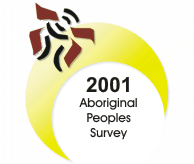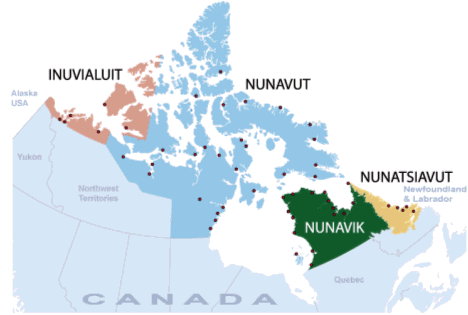Common menu bar links
Archived Content
Information identified as archived is provided for reference, research or recordkeeping purposes. It is not subject to the Government of Canada Web Standards and has not been altered or updated since it was archived. Please "contact us" to request a format other than those available.
 The Health of Inuit Children: Fact Sheet
The Health of Inuit Children: Fact Sheet
By Anne Guèvremont and Dafna Kohen
Health Status
- In 2001, the majority (79%) of Inuit children 0 to 14 years of age were rated as being in excellent or very good health. This was lower than the average (87%) for all children in Canada1.
- Inuit children in Labrador (83%) and the Inuvialuit region (81%) were more likely than Inuit children in both Nunavut (76%) and Nunavik (73%) to be rated as being in excellent or very good health.
Chronic Conditions
- Inuit Children were less likely than other Aboriginal children to report a chronic condition. About one-third of Inuit children had been diagnosed with a chronic condition. Ear infections or ear problems topped the list at 11%. However, since access to health care professionals is more limited in the Arctic, the rate of diagnosed chronic condition could be underestimated.
Contact with Health Care Professionals
Doctors rarely work in Inuit communities on a regular basis. Medical emergencies require evacuation to southern hospitals and many Inuit are sent to the South for appointments with medical specialists, diagnosis and treatments. Inuit communities have health centers staffed by at least one nurse, and this is usually the first point of contact for most Inuit children with the medical system.
- Consequently, in 2001, Inuit children were far less likely (46%) than all children in Canada (85%) to have had contact with a doctor. They were almost two and half times more likely than all children in Canada to have seen a nurse.
- Inuit children in Nunavik and Labrador were more likely than those in the Inuvialuit region, and almost twice as likely as children in Nunavut, to have had contact with a doctor.
Children are embracing affectionately
Chart 1
Inuit children were less likely to have had contact with a doctor in the last 12 months (family physician, pediatrician or other specialist) compared to all children in Canada
Dental Care
Most Inuit communities do not have a resident dentist, although dentists from southern Canada fly into remote communities throughout the year. As a result, only the most serious dental issues get treated upon a dentist’s visit. In dental emergencies, Inuit are evacuated by air to the South for treatment. Trips south are also required for consultation with dental specialists.
- In 2001, Inuit children 2 to14 years old received dental treatment less often than all children in Canada.
- Inuit children in Labrador, the Inuvialuit region, and Nunavik received dental care significantly more often than children from Nunavut.
- Approximately a quarter of Inuit children from Nunavut, Nunavik and the Inuvialuit region, and significantly more from Labrador were reported to be in need of dental care.
- Almost half of the Inuit respondents in need of dental care reported lack of access as the primary reason they did not have an appointment.
Breastfeeding
According to The Public Health Agency of Canada, breastfeeding is the best way to provide healthy food for the growth and development of infants.
- Inuit children were less likely than all children in Canada to be breastfed. However, when Inuit children were breastfed it was for a longer period of time.
- The proportion of Inuit children who were breastfed for more than 6 months was higher than the national average in three (Nunavut, Nunavik and Labrador) of the four Inuit regions.
Chart 2
Inuit children who were breastfed were more likely to be breastfed for more than six months compared to all children in Canada
Breakfast
The Dieticians of Canada recommend that all children start their day with a good breakfast. Children who eat breakfast perform better at school, have healthier weights, and eat more essential nutrients.
- When compared with similar data from the National Longitudinal Survey of Children and Youth, it was found that Inuit children 12 to14 years of age reported eating breakfast just as often all children in Canada.
- In 2001, most Inuit children 6 to14 years of age (82%) reported eating breakfast 5 to 7 days a week.
- Children from the Inuvialuit region and Nunavik reported eating breakfast more often than children from Nunavut and Labrador.
Children playing with puppies
About this report
This Inuit fact sheet is one in a series based on data from the 2001 Aboriginal Peoples Survey (APS). This report is a joint publication between The Social and Aboriginal Statistics Division and The Health Information and Research Division at Statistics Canada, as well as Inuit Tapiriit Kanatami. For more information, see the report entitled: The Health of Inuit Children: Report /bsolc/english/bsolc?catno=89-627-X2007003.
Unless otherwise stated, data are for children aged 0 to14. Information for Inuit children was gathered from the “person most knowledgeable” (PMK) about the child. In most cases the PMK was the birth parent (mother or father), but it could also have been a grandparent, an aunt or an uncle.
For this report, Inuit children were those who had Inuit identity along with those who had Inuit identity combined with North American Indian or Métis identity.
The Canadian Arctic refers to the four Inuit regions where the majority of Inuit live 1) the northern coastal region of Labrador; 2) Nunavik in northern Quebec; 3) the territory of Nunavut; 4) the Inuvialuit region in the Northwest Territories.

For this fact sheet, “Labrador” consists of Rigolet, Happy Valley-Goose Bay, Makkovik, Nain and Postville. (This makes it different from the Nunatsiavut region, which excludes Happy Valley-Goose Bay and includes Hopedale). The Inuvialuit region consists of the following communities: Inuvik, Aklavik, Sachs Harbour, Paulatuk, Ulukhaktok (Holman) and Tuktoyaktuk.
Artist information
Alootook Ipellie was born in a hunting camp on the north coast of Frobisher Bay in the Northwest Territories. He grew up in Iqaluit (formerly Frobisher Bay), and had a multifaceted career in the fine arts. As a graphic artist, cartoonist, photographer and writer, he contributed to many Inuit publications in the Canadian Arctic until his passing in September 2007.
Notes:
- For this Fact Sheet the term “all children in Canada” is used to refer to data from the National Longitudinal Survey of Children and Youth (NLSCY). Excluded are children living in the territories. However, some Inuit children living elsewhere in Canada may be included here.
You need to use the free Adobe Reader to view PDF documents. To view (open) these files, simply click on the link. To download (save) them, right-click on the link. Note that if you are using Internet Explorer or AOL, PDF documents sometimes do not open properly. See Troubleshooting PDFs. PDF documents may not be accessible by some devices. For more information, visit the Adobe website or contact us for assistance.

